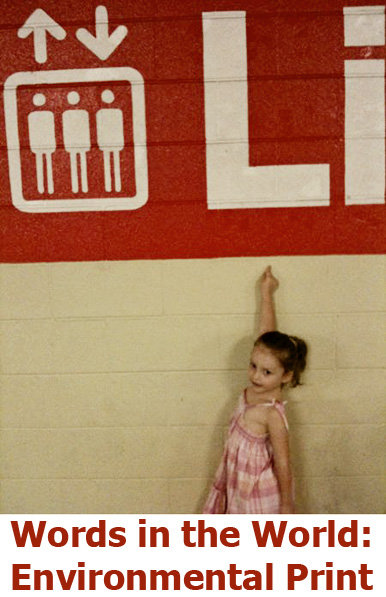Words in the World
This post is by Catherine Oehlman of Squigglemum.
Text isn’t limited to books. Environmental print is everywhere. It’s probably in every room in your home, it’s all over the place at the shops, it’s on street signs and billboards and buildings and more. If you want to give your kids a head start in reading there is so much you can do using words in the world around them.
Have you had that experience where you are going down the supermarket aisle and your toddler points to a product and reads the title, even though you know they can’t read yet? It stops many a parent in their tracks as they struggle to get their head around it! My daughter did it the other day and even surprised me. We were in the cereal aisle, and Daddy’s favourite was all sold out. Oh what to do? We stood looking at the boxes for a while before Little Miss 3 piped up and said, “How about that Macadamia and Honey one Mum?” Once I picked my jaw up off the floor I asked her how she knew it said Macadamia and Honey. It’s not a cereal we’ve ever bought before and I haven’t seen an ad for it on TV during kid-watching-hours. She just shrugged her shoulders and said, “I don’t know. There’s macadamias on the picture here and I can see m-m-m, and there’s a honey twirler over there so it must be.” As a teacher and a mother I couldn’t ask for more than that.
There’s a whole lot of detective work involved in learning to read. It’s all about making connections, and putting together the pieces of a puzzle.
Letters + sounds + pictures + context = meaning
My daughter can’t sing the alphabet yet, but she knows some personally significant letters like m-for-Mummy, d-for-Daddy, all the letters of her own name and a few others. So in the case of the cereal box she used a letter and sound she knew (M) + the pictures on the box and her own prior knowledge (we have a macadamia tree in the backyard) + her understanding of where we were and what type of product we were looking at = Macadamia and Honey Cereal. In an early, simple form… that’s reading.
There are lots of ways you can encourage your child to start making these connections, WITHOUT flashcards!
- Help your child to get to know the letters
in their name, especially the initial letter.
- Make sure they know the sound their letter makes.
- Put their name on their bedroom door.
- Look for their special letter when you’re at the shops together.
- Give them their own grocery list with a couple of easy, familiar items drawn and labelled (MILK is a good one to start with).
- Cut out letters from catalogues and magazines.
- Point out letters and signs when you’re driving, and read them aloud.
- Have fun with words together!
In addition to daily reading aloud together, exploring environmental print is a great way to help your kids become great little readers. You don’t have to do any heavy teaching. Simply look for opportunities to help your child make connections with the words in their world. They’ll be surprising you before you know it.
Thank you to the wonderful Catherine Oehlman, aka SquiggleMum for this guest post. Cath is a mother, teacher, writer, picture book lover and award winning blogger. You can find her squiggling about literacy and other topics close to her heart in many online and print publications.



This is just where my son is at with literacy at the moment. They notice so much, he looks at labels all the time and says things like "They make bbq sauce with tomatoes and onions". And he always knows what type of juice is in juice bottles. He can easily recognise the first letter of his name B, but he still doesn't realise that the other letters matter too (so he can get mixed up at preschool with other children's name labels that start with B). But it is all so exciting to see them learning.
Those are great ideas to teach how to read! 🙂 And I love it that we don't need to make or buy special flashcards to do all that!
Thank you for this post! So many great ideas. On the ride home from the grocery store, my 3-year old wanted me to tell him what every single road sign said.
You can bet I'll be making him a short grocery list the next time we head to the store to pick up soy milk and eggs (complete with drawings) 🙂
great ideas here for learning to read while playing & interacting.
It IS detective work, and they are clever little detectives to make all those connections. It's such an exciting time in her life – thanks for sharing it!
My son, 3.5 yrs old picked up letters and sounds through environmental print. It is a fun and wonderful way of learning rather than having specific lessons on learning the alphabets. Detective work is very challenging as it engages their 5 senses to learn to observe and to attend. He hasn’t learn how to read yet but is already building short phonetic words. Learning happens anytime and anywhere ;-). Great ideas and great fun!!!
It is magical to watch, isn’t it. 🙂
It sure is..the process of unfolding an emergent reader is an exciting journey 🙂